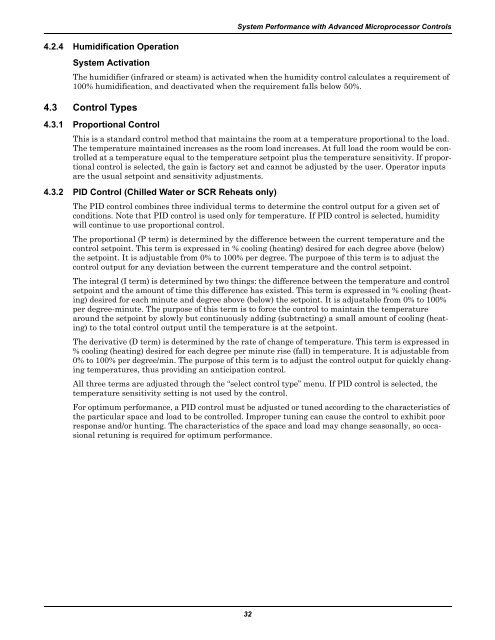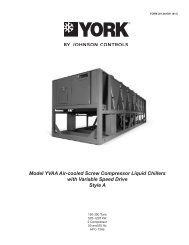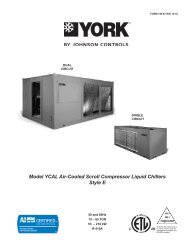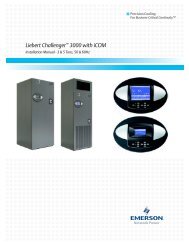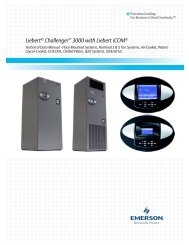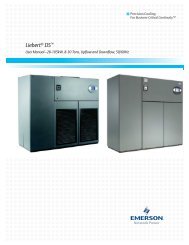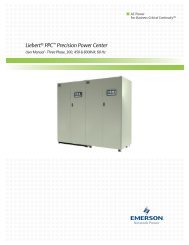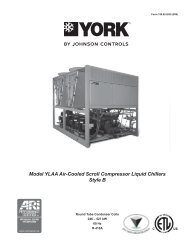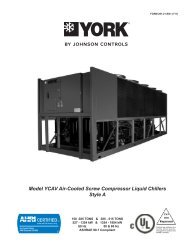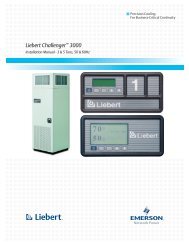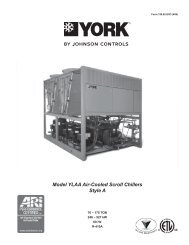Liebert Challenger 3000
Liebert Challenger™ 3000 Operation & Maintenance Manual - DCES
Liebert Challenger™ 3000 Operation & Maintenance Manual - DCES
Create successful ePaper yourself
Turn your PDF publications into a flip-book with our unique Google optimized e-Paper software.
4.2.4 Humidification OperationSystem ActivationSystem Performance with Advanced Microprocessor ControlsThe humidifier (infrared or steam) is activated when the humidity control calculates a requirement of100% humidification, and deactivated when the requirement falls below 50%.4.3 Control Types4.3.1 Proportional ControlThis is a standard control method that maintains the room at a temperature proportional to the load.The temperature maintained increases as the room load increases. At full load the room would be controlledat a temperature equal to the temperature setpoint plus the temperature sensitivity. If proportionalcontrol is selected, the gain is factory set and cannot be adjusted by the user. Operator inputsare the usual setpoint and sensitivity adjustments.4.3.2 PID Control (Chilled Water or SCR Reheats only)The PID control combines three individual terms to determine the control output for a given set ofconditions. Note that PID control is used only for temperature. If PID control is selected, humiditywill continue to use proportional control.The proportional (P term) is determined by the difference between the current temperature and thecontrol setpoint. This term is expressed in % cooling (heating) desired for each degree above (below)the setpoint. It is adjustable from 0% to 100% per degree. The purpose of this term is to adjust thecontrol output for any deviation between the current temperature and the control setpoint.The integral (I term) is determined by two things: the difference between the temperature and controlsetpoint and the amount of time this difference has existed. This term is expressed in % cooling (heating)desired for each minute and degree above (below) the setpoint. It is adjustable from 0% to 100%per degree-minute. The purpose of this term is to force the control to maintain the temperaturearound the setpoint by slowly but continuously adding (subtracting) a small amount of cooling (heating)to the total control output until the temperature is at the setpoint.The derivative (D term) is determined by the rate of change of temperature. This term is expressed in% cooling (heating) desired for each degree per minute rise (fall) in temperature. It is adjustable from0% to 100% per degree/min. The purpose of this term is to adjust the control output for quickly changingtemperatures, thus providing an anticipation control.All three terms are adjusted through the “select control type” menu. If PID control is selected, thetemperature sensitivity setting is not used by the control.For optimum performance, a PID control must be adjusted or tuned according to the characteristics ofthe particular space and load to be controlled. Improper tuning can cause the control to exhibit poorresponse and/or hunting. The characteristics of the space and load may change seasonally, so occasionalretuning is required for optimum performance.32


